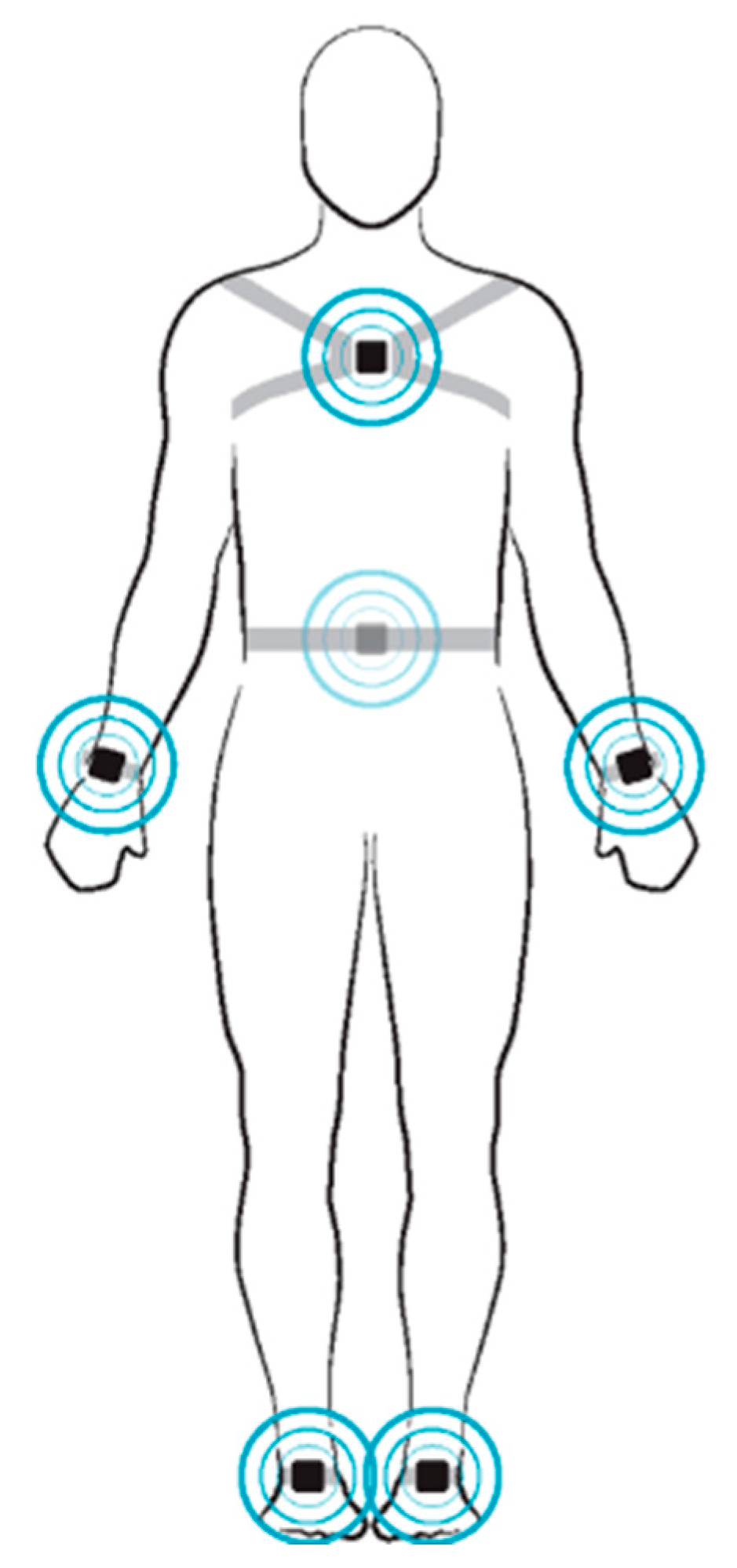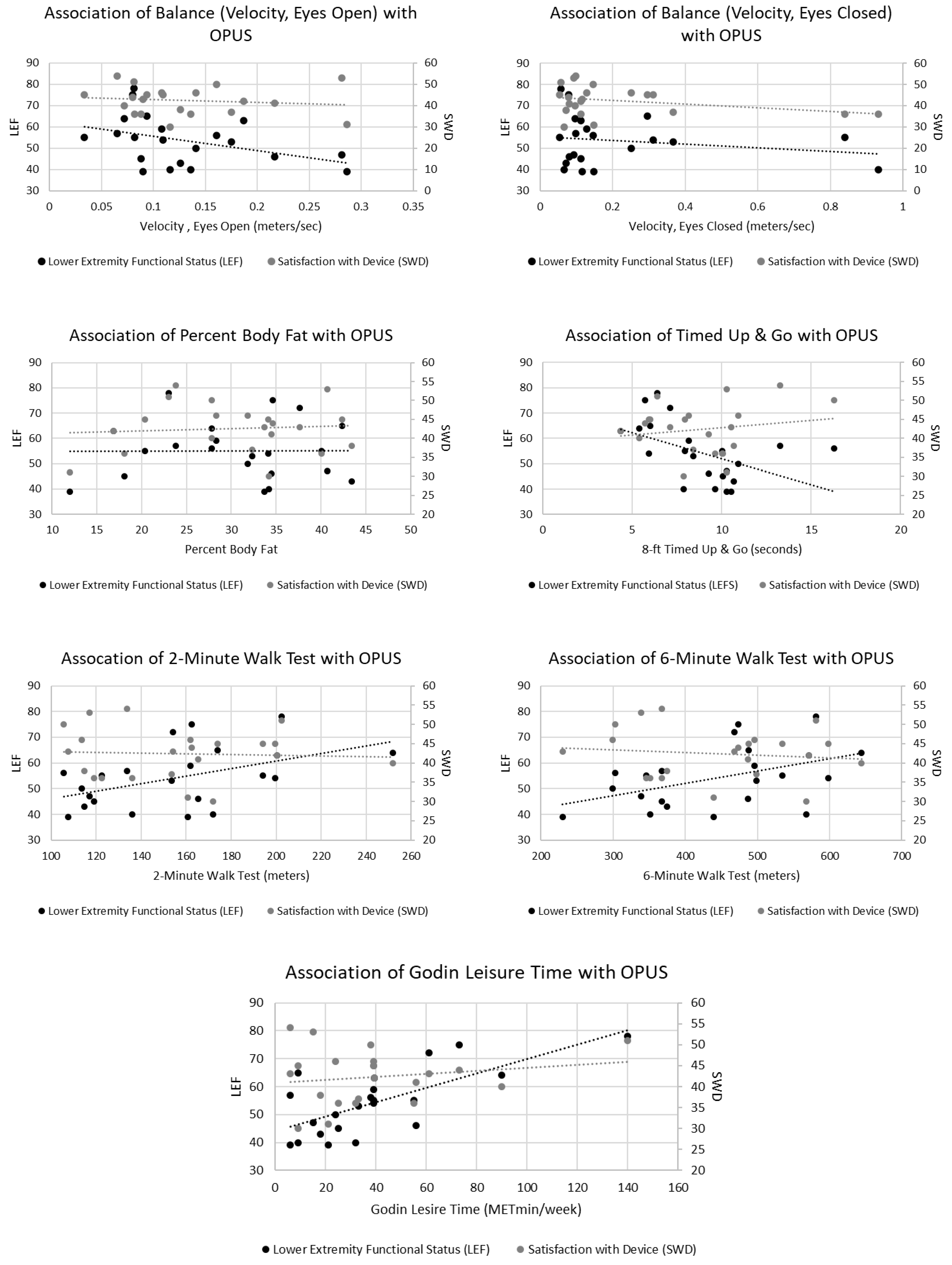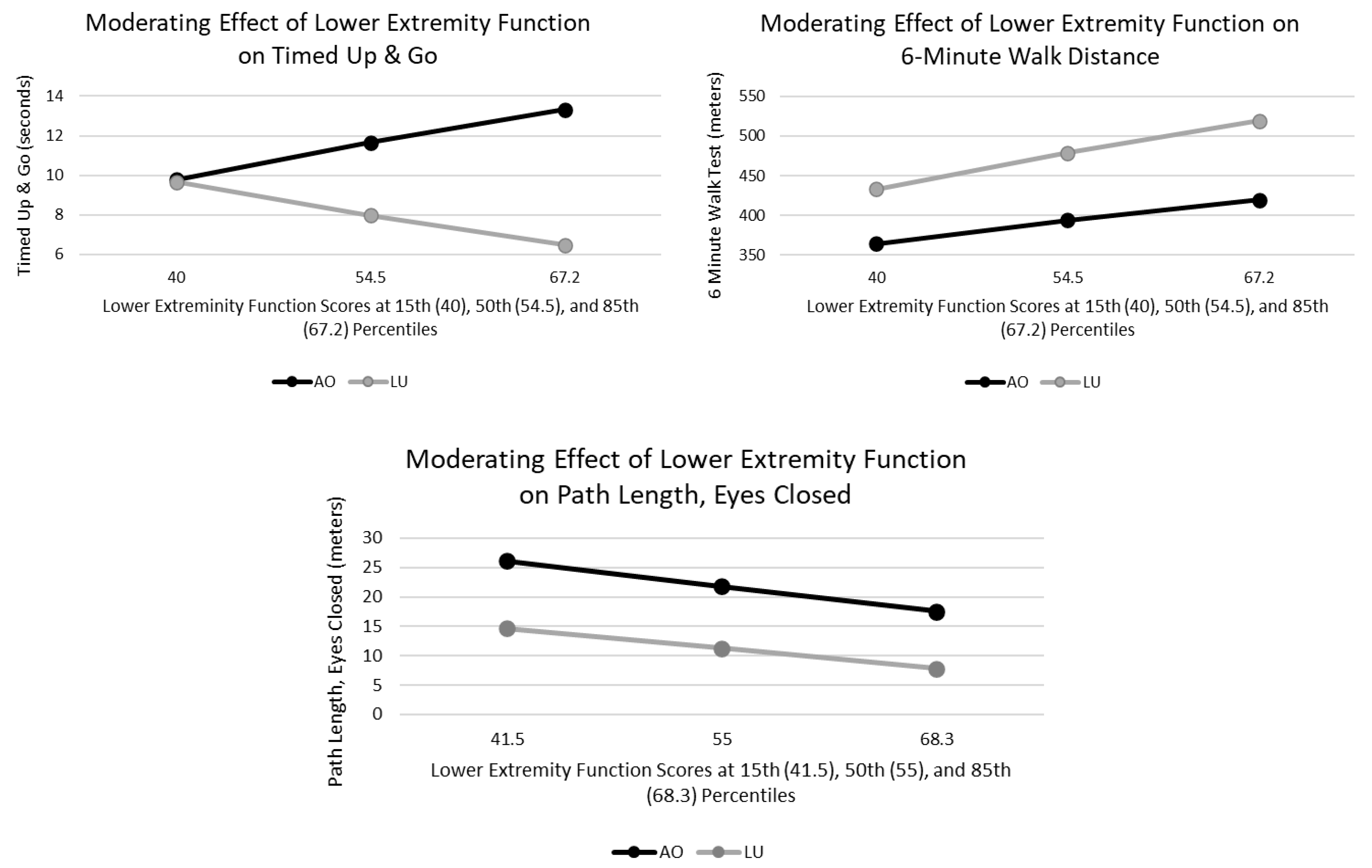Correlates of Orthotic Prosthetic User Survey, Performance-Based Outcome Measures and Balance in Lower Limb Prosthesis Users
Abstract
1. Introduction
2. Materials and Methods
2.1. Participants
2.2. Measures
2.3. Procedures
2.4. Statistical Analysis
3. Results
4. Discussion
5. Conclusions
Author Contributions
Funding
Institutional Review Board Statement
Informed Consent Statement
Data Availability Statement
Conflicts of Interest
Abbreviations
| OPUS | Orthotic Prosthetic User Survey |
| LEF | Lower Extremity Functional Status |
| SWD | Satisfaction With Devices |
| GLTQ | Godin Leisure-Time Exercise Questionnaire |
| TUG test | Timed Up and Go test |
| 2MWT | Two-minute walk test |
| 6MWT | Six-minute walk test |
| LU | Lower unilateral |
| AO | All other |
| CoP | Center or Pressure |
| QoL | Quality of Life |
| ADL | Activities of Daily Living |
| IMU | Inertial Measurement Units |
| PLEO | Path length with eyes open |
| PLEC | Path length eyes closed |
| VEO | Velocity eyes open |
| VEC | Velocity eyes closed |
| OPUS | Orthotic Prosthetic User Survey |
References
- Küçükdeveci, A.A.; Tennant, A.; Grimby, G.; Franchignoni, F. Strategies for assessment and outcome measurement in physical and rehabilitation medicine: An educational review. J. Rehabil. Med. 2011, 43, 661–672. [Google Scholar] [CrossRef] [PubMed]
- Heinemann, A.W.; Ehrlich-Jones, L.; Connelly, L.; Semik, P.; Fatone, S. Enhancing quality of prosthetic services with process and outcome information. Prosthet. Orthot. Int. 2017, 41, 164–170. [Google Scholar] [CrossRef]
- Condie, E.; Scott, H.; Treweek, S. Lower Limb Prosthetic Outcome Measures: A Review of the Literature 1995 to 2005. JPO J. Prosthet. Orthot. 2006, 18, P13–P45. [Google Scholar] [CrossRef]
- Schack, J.; Mirtaheri, P.; Steen, H.; Gjøvaag, T. Assessing mobility for persons with lower limb amputation: The Figure-of-Eight Walk Test with the inclusion of two novel conditions. Disabil. Rehabil. 2021, 43, 1323–1332. [Google Scholar] [CrossRef] [PubMed]
- Heinemann, A.W.; Connelly, L.; Ehrlich-Jones, L.; Fatone, S. Outcome Instruments for Prosthetics. Phys. Med. Rehabil. Clin. N. Am. 2014, 25, 179–198. [Google Scholar] [CrossRef]
- Ramstrand, N.; Brodtkorb, T.-H. Considerations for developing an evidenced-based practice in orthotics and prosthetics. Prosthet. Orthot. Int. 2008, 32, 93–102. [Google Scholar] [CrossRef]
- Gailey, R.S.; Gaunaurd, I.; Agrawal, V.; Finnieston, A.; Otoole, C.; Tolchin, R. Application of self-report and performance-based outcome measures to determine functional differences between four categories of prosthetic feet. J. Rehabil. Res. Dev. 2012, 49, 597–612. [Google Scholar] [CrossRef]
- Deathe, A.B.; Wolfe, D.L.; Devlin, M.; Hebert, J.S.; Miller, W.C.; Pallaveshi, L. Selection of outcome measures in lower extremity amputation rehabilitation: ICF activities. Disabil. Rehabil. 2009, 31, 1455–1473. [Google Scholar] [CrossRef]
- Brehm, M.; A Bus, S.; Harlaar, J.; Nollet, F. A candidate core set of outcome measures based on the international classification of functioning, disability and health for clinical studies on lower limb orthoses. Prosthet. Orthot. Int. 2011, 35, 269–277. [Google Scholar] [CrossRef]
- Wurdeman, S.R.; Stevens, P.M.; Campbell, J.H. Mobility Analysis of AmpuTees (MAAT 6): Mobility, Satisfaction, and Quality of Life among Long-Term Dysvascular/Diabetic Prosthesis Users-Results of a Cross-Sectional Analysis. J. Prosthet. Orthot. 2021, 33, 161–167. [Google Scholar] [CrossRef]
- Fogelberg, D.J.P.; Allyn, K.J.L.; Smersh, M.B.; Maitland, M.E. What People Want in a Prosthetic Foot: A Focus Group Study. JPO J. Prosthet. Orthot. 2016, 28, 145–151. [Google Scholar] [CrossRef]
- Asano, M.; Rushton, P.; Miller, W.C.; Deathe, B.A. Predictors of quality of life among individuals who have a lower limb amputation. Prosthet. Orthot. Int. 2008, 32, 231–243. [Google Scholar] [CrossRef]
- Levasseur, M.; Desrosiers, J.; Noreau, L. Is social participation associated with quality of life of older adults with physical disabilities? Disabil. Rehabil. 2004, 26, 1206–1213. [Google Scholar] [CrossRef]
- Dijkers, M.P. Individualization in quality of life measurement: Instruments and approaches. Arch. Phys. Med. Rehabil. 2003, 84, S3–S14. [Google Scholar] [CrossRef]
- Bettoni, E.; Ferriero, G.; Bakhsh, H.; Bravini, E.; Massazza, G.; Franchignoni, F. A systematic review of questionnaires to assess patient satisfaction with limb orthoses. Prosthet. Orthot. Int. 2016, 40, 158–169. [Google Scholar] [CrossRef]
- Magnusson, L.; Ramstrand, N.; Fransson, E.; Ahlstrãm, G. Mobility and satisfaction with lower-limb prostheses and orthoses among users in Sierra Leone: A cross-sectional study. J. Rehabil. Med. 2014, 46, 438–446. [Google Scholar] [CrossRef]
- Funk, L.; Thiessen, D.; Wright, V.; Andrysek, J.; Rispin, K. Reliability and validity of the Lower Limb Function Questionnaire when completed by young adult orthotic and prosthetic device users. Disabil. Rehabil. Assist. Technol. 2017, 12, 262–271. [Google Scholar] [CrossRef]
- Heinemann, A.W.; Bode, R.K.; O’Reilly, C. Development and measurement properties of the Orthotics and Prosthetics Users’ Survey (OPUS): A comprehensive set of clinical outcome instruments. Prosthet. Orthot. Int. 2003, 27, 191–206. [Google Scholar] [CrossRef]
- Burger, H.; Giordano, A.; Mlakar, M.; Albensi, C.; Brezovar, D.; Franchignoni, F. Cross-cultural adaptation and Rasch validation of the Slovene version of the Orthotics and Prosthetics Users’ Survey (OPUS) Client Satisfaction with Device (CSD) in upper-limb prosthesis users. Ann. Phys. Rehabil. Med. 2019, 62, 168–173. [Google Scholar] [CrossRef]
- Schmid, M.; Beltrami, G.; Zambarbieri, D.; Verni, G. Centre of pressure displacements in trans-femoral amputees during gait. Gait Posture 2005, 21, 255–262. [Google Scholar] [CrossRef]
- Cikajlo, I.; Mitić, J.; Burger, H. The effect of weight-bearing training with visual feedback on balance and prosthetic loading in trans-tibial amputees following vascular disease—A pilot randomized control trial. Ann. Med. 2025, 57, 2447408. [Google Scholar] [CrossRef]
- Eskridge, S.L.; Clouser, M.C.; McCabe, C.T.; Watrous, J.R.; Galarneau, M.R. Self-reported Functional Status in US Service Members After Combat-Related Amputation. Am. J. Phys. Med. Rehabil. 2019, 98, 631–635. [Google Scholar] [CrossRef] [PubMed]
- Amira Adlan, N.; Arifin, N.; Azuan Abu Osman, N.; Hasbollah, H.R.; Yatim, S.M.; Yusof, Y.M. Lower Extremity Functional And Mobility Status In Transfemoral Amputees In Malaysia: A Preliminary Study. Sys. Rev. Pharm. 2020, 11, 1661–1667. [Google Scholar]
- DadeMatthews, O.; Roper, J.A.; Vazquez, A.; Shannon, D.; Sefton, J.M. Virtual Assessment of Functional Mobility in Lower Extremity Prosthesis Clients: An Exploratory Study. Arch. Rehabil. Res. Clin. Transl. 2024, 6, 100355. [Google Scholar] [CrossRef]
- Seth, M.; Horne, J.R.; Pohlig, R.T.; Sions, J.M. Pain, Balance-Confidence, Functional Mobility, and Reach Are Associated With Risk of Recurrent Falls Among Adults With Lower-Limb Amputation. Arch. Rehabil. Res. Clin. Transl. 2023, 5, 100309. [Google Scholar] [CrossRef] [PubMed]
- Ku, P.X.; Abu Osman, N.A.; Wan Abas, W.A.B. Balance control in lower extremity amputees during quiet standing: A systematic review. Gait Posture 2014, 39, 672–682. [Google Scholar] [CrossRef]
- Carpenter, M.G.; Frank, J.S.; Silcher, C.P.; Peysar, G.W. The influence of postural threat on the control of upright stance. Exp. Brain Res. 2001, 138, 210–218. [Google Scholar] [CrossRef]
- Sions, J.M.; Beisheim, E.H.; Manal, T.J.; Smith, S.C.; Horne, J.R.; Sarlo, F.B. Differences in Physical Performance Measures Among Patients with Unilateral Lower-Limb Amputations Classified as Functional Level K3 Versus K4. Arch. Phys. Med. Rehabil. 2018, 99, 1333–1341. [Google Scholar] [CrossRef]





| Characteristics | Total (N = 22) | Lower Unilateral (N = 13) | All Others (N = 9) |
|---|---|---|---|
| Age (y) | 52.1 ± 14.2 | 49.8 ± 14.5 | 55.4 ± 14.5 |
| Height (cm) | 172.4 ± 9.5 | 172.7 ± 7.1 | 171.9 ± 21.1 |
| Mass (kg) | 91.9 ± 21.5 | 96.2 ± 14.8 | 85.4 ± 27.0 |
| Amputation Duration (years) | 15.1 ± 17.2 | 8.6 ± 10.5 | 24.7 ± 20.2 |
| Classification | |||
| Right Transtibial | 6 | 6 | |
| Left Transtibial | 7 | 7 | |
| Right Transfemoral | 1 | 1 | |
| Left Transfemoral | 1 | 1 | |
| Bilateral Transtibial | 3 | 3 | |
| Bilateral Transfemoral | 1 | 1 | |
| Bilateral Knee Disarticulation | 1 | 1 | |
| Hip Disarticulation | 2 | 2 |
| Lower Unilateral (LU) | All Others (AO) | ANOVA | |
|---|---|---|---|
| Path Length, eyes open (m) | 5.6 ± 3.3 | 8.3 ± 2.8 | F(1,19) = 3.4, p = 0.078 |
| Path Length, eyes closed (m) | * 10.3 ± 7.8 | 23.6 ± 13.9 | F(1,19) = 7.8, p = 0.010 |
| Velocity, eyes open (m/s) | 0.13 ± 0.05 | 0.12 ± 0.08 | F(1,19) = 0.6, p = 0.418 |
| Velocity, eyes closed (m/s) | 0.16 ± 0.11 | 0.28 ± 0.34 | F(1,19) = 0.5, p = 0.469 |
| Percent Body Fat | 32.8 ± 7.6 | 26.3 ± 9.4 | F(1,20) = 3.0, p = 0.096 |
| TUG (s) | * 7.4 ± 2.1 | 10.8 ± 2.4 | F(1,20) = 11.3, p = 0.003 |
| 2-Minute Walk Test (m) | 167.4 ± 39.9 | 138.2 ± 29.5 | F(1,20) = 3.4, p = 0.077 |
| 6-Minute Walk Test (m) | * 492.2 ± 104.0 | 380.6 ± 93.3 | F(1,20) = 6.6, p = 0.018 |
| Godin Leisure Time (METmin/Week) | 45.3 ± 37.6 | 30.8 ± 18.3 | F(1,20) = 1.1, p = 0.301 |
| Lower Extremity Function | * 58.6 ± 12.1 | 48.0 ± 7.7 | F(1,20) = 5.4, p = 0.031 |
| Satisfaction with Device | 43.0 ± 5.9 | 41.3 ± 7.4 | F(1,20) = 0.3, p = 0.550 |
Disclaimer/Publisher’s Note: The statements, opinions and data contained in all publications are solely those of the individual author(s) and contributor(s) and not of MDPI and/or the editor(s). MDPI and/or the editor(s) disclaim responsibility for any injury to people or property resulting from any ideas, methods, instructions or products referred to in the content. |
© 2025 by the authors. Licensee MDPI, Basel, Switzerland. This article is an open access article distributed under the terms and conditions of the Creative Commons Attribution (CC BY) license (https://creativecommons.org/licenses/by/4.0/).
Share and Cite
Smith, J.D.; Guerra, G. Correlates of Orthotic Prosthetic User Survey, Performance-Based Outcome Measures and Balance in Lower Limb Prosthesis Users. Prosthesis 2025, 7, 66. https://doi.org/10.3390/prosthesis7030066
Smith JD, Guerra G. Correlates of Orthotic Prosthetic User Survey, Performance-Based Outcome Measures and Balance in Lower Limb Prosthesis Users. Prosthesis. 2025; 7(3):66. https://doi.org/10.3390/prosthesis7030066
Chicago/Turabian StyleSmith, John D., and Gary Guerra. 2025. "Correlates of Orthotic Prosthetic User Survey, Performance-Based Outcome Measures and Balance in Lower Limb Prosthesis Users" Prosthesis 7, no. 3: 66. https://doi.org/10.3390/prosthesis7030066
APA StyleSmith, J. D., & Guerra, G. (2025). Correlates of Orthotic Prosthetic User Survey, Performance-Based Outcome Measures and Balance in Lower Limb Prosthesis Users. Prosthesis, 7(3), 66. https://doi.org/10.3390/prosthesis7030066






